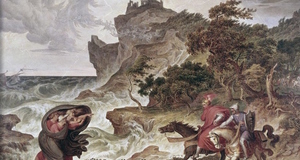Religious Intolerance in The Female American, Or, The Adventures of Unca Eliza Winkfield
By
2011, Vol. 3 No. 12 | pg. 1/1
KEYWORDS:
Published in 1767, The Female American, Or, The Adventures of Unca Eliza Winkfield claims to be the spiritual autobiography of an Unca Eliza Winkfield. Like Defoe’s Robinson Crusoe, this narrative is peppered with bits of true historical details and events in order to convince the reader that the story is true. Despite the inaccuracies, the purpose of the novel is to spread the word of Christianity. At first glance, an interpretation of The Female American may appear to be a convincing argument for religious imperialism, but if one takes a closer look they will find that the story is an appalling example of religious intolerance. Throughout the story, Unca Eliza Winkfield finds solace in her religion. When she is stressed or troubled she prays, or reads her pocket-sized Bible that she carries everywhere with her. It is not surprising that she should turn to religion in these moments because of her Christian upbringing; however the disapproval that she has for the religion of the Indians is decidedly unexpected. As Unca Eliza tells of her formerly Pagan mother: “in a little time the princess became convinced of her errors, and her good understanding helped to forward her conversion” (Winkfield 41). Religious imperialism is often understood as spreading beliefs through any means possible. In Unca Eliza’s story, even she admits that “we readily believe those whom we love,” which indicates that Unca Eliza’s father was able to convert her mother because of this. Thinking of her mother’s religion as an “error,” is a sign of religious intolerance. Additionally, the phrase “conversion” can be seen as troubling. Convert often carries negative connotations, in that something needs to be changed into something better: the original is not good enough or does not suit a purpose. Reading further, one can see that Unca Eliza, the heroine herself, was converted by her uncle (on her father’s side).About her religious education that she received from her uncle she says, “his lectures convinced the understanding, they converted the heart, and made me love and know religion at the same time” (Winkfield 52). The phrasing here should be noted. His lectures “convinced” her, indicating that she had to be persuaded. The lectures “converted” her heart, again, insinuating that something was wrong with her heart before. Finally, she says he “made” her “love and know religion.” The word “made” is often associated with the negative. He “made” her do this or he “made” her do that. Again, using the word “made” implies that she would not have normally loved or known religion on her own. Shortly before the Unca Eliza encounters the Indians, she investigates the temple of the idol. She encounters what she admits is a beautifully made crown, along with many precious stones and gold jewelry. Then she finds the body of the idol which allows her to see for miles, and is startled by the ability of the idol to carry her voice, saying, “What a knowledge of mechanics must the ancients have had!” (Winkfield 80). Unca Eliza seems to have no problem in admiring the beauty and craftsmanship of the riches she finds. Regarding the idol, she is truly impressed by the intelligence needed to craft such a device and walking home reflects on the “extraordinary things” that she had seen. Clearly the Indians had intelligence. They had the ability to find materials like gold and precious stones, the skill to turn that material into beautiful objects, and knowledge of the architecture needed to create both the temple and the idol. One of the arguments that is often used for religious imperialism is that those being converted do not know any better. Yet if the Indians had the ability and knowledge to create such wondrous things, then Unca Eliza, along with her audience, should realize that they do not need her interference. The day comes that Unca Eliza thinks to “endeavour to convert” the Indians (Winkfield 83). She says, “I thought the extraordinariness of the event, my speaking to them, would appear miraculous, fill them with awe, and prejudice their minds greatly in favour of what I should say to them” (Winkfield 84). Winkfield continues in the vein of religious imperialism. Just as her father converted her mother using her love against her, Unca Eliza attempts to convert the Indians by speaking their language and using their technology. Again the phrasing here should be noted. Unca Eliza wishes to “prejudice their minds,” and “prejudice” is another word with negative connotation. Perhaps the most disturbing part of the story is that Unca Eliza is so quick to condemn what she perceives as the idolatry of the Indians, yet she uses this very same idolatry in her efforts to convert them. Unca Eliza does not even attempt to disguise this ploy in her story. After speaking through the idol, the Indians flee in fear. Unca Eliza calls for them to return saying, “provoke me not, to destroy you, before you can reach your own shore” (Winkfield 96). This time Winkfield is continuing her religious imperialism through fear. Even Unca Eliza questions whether or not such actions are sin. She calls it “artifice,” another word with negative connotations, meaning trickery or guile, but does not show any remorse since it stops the Indians from fleeing. Unfortunately this whole passage indicates that Unca Eliza thinks herself better than the Indians. She automatically places them beneath her because of their religion and continues to give commands: “I thought it would be best to dismiss them at this time, and order some of them to come again the next week” (Winkfield 98). Her supposed superiority and refusal to accept the Indians’ original religion cannot be overlooked by her audience as a clear example of religious intolerance. Unca Eliza claims later that, “here a people, who had no other guide but their reason, no sooner heard Christianity plainly and firmly expounded to them, but they soon embraced it” (Winkfield 120). Unca Eliza seems to be taking pains to explain that these people “embraced” Christianity all on their own, because they saw it was reasonable. Not only is this untrue, as she herself acted as their guide and used fear along with their own religion and technology against them, but it implies that the Indians quickly saw that Christianity was more reasonable than their own religion. Her own intolerance of their religion is shown through these words. In The Female American, Or, The Adventures of Unca Eliza Winkfield, Unca Eliza Winkfield, just as her mother does, embraces Christianity. Unfortunately in the process, she shuns the religion of the Indians. Her viewing of the Pagan religion as an “error” and her refusal to see that the Indians do not need her interference, leads to her hypocritically using idolatry against them. Her actions leave no doubt in the minds of her audience that this story is one of religious intolerance and as a result, an argument against religious imperialism. ReferencesWinkfield, Unca Eliza. The Female American, Or, The Adventures of Unca Eliza Winkfield. Ed. Michelle Burnham. Peterborough, Ont.: Broadview, 2001. Print. Suggested Reading from Inquiries Journal
Inquiries Journal provides undergraduate and graduate students around the world a platform for the wide dissemination of academic work over a range of core disciplines. Representing the work of students from hundreds of institutions around the globe, Inquiries Journal's large database of academic articles is completely free. Learn more | Blog | Submit Latest in Literature |













